BRK DICON M300 Handleiding
BRK DICON
Rookmelder
M300
Bekijk gratis de handleiding van BRK DICON M300 (2 pagina’s), behorend tot de categorie Rookmelder. Deze gids werd als nuttig beoordeeld door 48 mensen en kreeg gemiddeld 4.1 sterren uit 24.5 reviews. Heb je een vraag over BRK DICON M300 of wil je andere gebruikers van dit product iets vragen? Stel een vraag
Pagina 1/2
PRODUCT SERIES
M300, M300AP, M300i, SA200
SA900, SA900Si, SA300 and SA300L
Dual Ionisation sensing chamber, particularly sensitive to fast flaming fires.
SUPERIOR FEATURES
• Battery Operated
• Operating Light (RED)
Flashes approximately every 45 seconds confirming unit is powered.
• Low Battery Warning
Unit ‘beeps‘ approximately every 45 seconds for at least 30 days when the battery needs replacing.
• Sensitivity Test Button
Test sensitivity, circuitry, battery, horn.
• Loud 85 Decibel Piezo Electric Alarm
Automatically resets when hazardous condition has passed.
• Easy Installation
Fixings supplied.
SPECIAL FEATURES
Each family of alarms supports several special features:-
‘AP’: Alarm Pause. Fitted to the SA900/SA300 and models with the suffix ‘AP’. Silence your smoke
alarm by momentarily pressing the test button. Ideal when non-emergency smoke (eg
cooking fumes) causes nuisance alarms. The red light flashes every 10 seconds to remind
you that the smoke alarm has been silenced. Your smoke alarm will automatically reset
after approximately 10 minutes.
‘i’ Interconnect. Fitted to models with the suffix ‘i’ Connect up to 12 alarms together so that
when one alarm sounds all properly connected alarms with this facility will follow.
‘S’ Sealed-in battery. Model numbers with the suffix ‘S’ have the battery sealed in to prevent
tampering.
For example a model SA900Si is an alarm with a sealed in battery that can be interconnected to other
alarms.
S M O K E
A L A R M S
SA900 / SA900Si / SA300L
Supplied complete with Long Life Lithium Powercell. Under normal use and conditions this lithium
powercell is guaranteed for 10 years, the typical life of the alarm. In the SA900Si the battery is sealed
in place and is not removable/replaceable.
BE PREPARED
Smoke and heat alarms properly installed and maintained are an essential part of a good home fire
safety programme. Review fire hazards and eliminate dangerous conditions whenever possible. When
fire strikes, a prepared and practiced escape plan could prove vital. Your local fire brigade may be
willing to advise you. Call them and ask. Consider and discuss the following safety hints:
• Ensure everyone is familiarized with the alarm signal.
• Always test doors with your hands before flinging them open. If they feel warm, fire
may be walled up behind them - leave closed and find another escape route.
• Don’t waste time collecting possessions. Rouse all occupants and leave the
building. Your life is more valuable!
•GET OUT. STAY OUT. GET THE FIRE BRIGADE OUT.
• Keep everyone in a set meeting place after your escape.
• If trapped inside, stay close to the floor, cover mouth with cloth, conserve breath as
you crawl to safety.
• Keep all doors and windows closed except for escape purposes.
• Prepare and practice an escape plan before a fire starts!
Draw a Floor Plan. Have Fire Drills Often. Practise Your Escape.
WHERE TO LOCATE
1. As a minimum, smoke alarms should be located between sleeping areas and potential sources of
fire such as living rooms and kitchens. In single storey homes with one sleeping area a smoke
alarm should be installed in the hallway, as close as possible to the living accommodation.
To ensure audibility in bedrooms it may be necessary to install more than one smoke alarm,
particularly if the hallway is more than 15m long. In single storey homes with two separate sleeping
areas, a minimum of two smoke alarms is required, one outside each sleeping area. In multilevel or
split level homes, as a minimum a smoke alarm should be installed on the ground floor between
the staircase and any rooms in which a fire might start and on each storey in circulation areas
which form part of the escape route (normally hallways and landings).
NOTE: Heat alarms should not be used in escape routes instead of smoke alarms. They should only
be used in the applications listed below in addition to smoke alarms and should always be
interconnected with smoke alarms.
2. Additional alarms should be installed in bedrooms in anticipation of fires originating there, caused
by faulty wiring, lights, appliances, smokers or other hazards.
3. For best protection, smoke alarms should be installed in every room in your home, apart from
those listed in the Locations to Avoid section. Heat alarms should be used in kitchens, boiler
rooms, laundry rooms, garages and such like, where smoke alarms would be unsuitable. All alarms
must be interconnected.
4. Install smoke alarms in circulation areas at a distance no greater than 7.5m from the farthest wall,
no greater than 7.5m from a door to any room in which a fire might start and no greater than 7.5m
from the next smoke alarm.
5. When heat alarms are installed in a room, they should be at a distance no greater than 5.3m from
the farthest wall, no greater than 5.3m from a door to any room in which a fire might start and no
greater than 5.3m from the next heat alarm.
6. As it is impossible to predict the source of a fire, the best location for an alarm is usually the centre
of a room or hallway. If it is necessary to place a smoke alarm on a wall, always locate the detection
element of the alarm 150mm to 300mm (6 to 12 inches) below the ceiling and the bottom of the
alarm above the level of doors and other openings. NOTE: Heat alarms must not be wall mounted.
7. In rooms with simple sloped, peaked or gabled ceilings, install smoke alarms on the ceiling
900mm (3 feet) from the highest point of the ceiling. ‘Dead air’ at the peak of a ceiling may prevent
smoke from reaching the alarm in time to provide an early warning.
OWNERS
MANUAL
For further information
please write to:
BRK Brands Europe Ltd,
Unit 6 Carter Court, Davy Way,
Waterwells Business Park,
Quedgeley, Gloucester, GL2 2DE,
United Kingdom
COVERS •Simple Fitting Instructions •Location Guide
•Operating Guide •Basic Fire Safety Tips
•Simple Maintenance Instructions
PLEASE KEEP THIS MANUAL IN A SAFE PLACE
IMPORTANT: PLEASE READ
AND RETAIN THIS OWNERS MANUAL
B A T T E R Y O P E R A T E D
When installing this alarm for use by others, please leave
this manual or a copy with the end user.
2502-B0001 RevA
IONISATION SMOKE ALARMS
M300, M300AP, M300i, SA200
and
SA900, SA900Si, SA300 and SA300L
2502-B0001_M300&SA900_GB MANUAL.qxd:2502-B0001_M300&SA900_GB MANUAL 16/9/09 09:25 Page 1
Caravan Holiday Home
1. The preferred position for fitting the smoke alarm is horizontally on the ceiling in the living area.
Avoid proximity to the kitchen
2. An additional smoke alarm may be fitted in one or more bedrooms.
3. DO NOT locate in kitchen or bathroom area. Cooking fumes and high humidity can trigger nuisance
alarms.
4. DO NOT locate smoke alarms close to exhaust fans or air conditioning units, which could draw
smoke away from the alarm.
Park Homes
1. If only one smoke alarm is to be fitted, it should be located horizontally on the ceiling, either in the
living room or the hall, but not in the proximity of either kitchen or bathroom.
2. Additional alarms can be fitted in bedrooms.
3. DO NOT locate alarm close to exhaust fans or air conditioning.
INSTALLATION
1. Open the cover and handle unit with care to avoid damage.
2. Locate keyhole slots.
3. Mark holes through alarm base. Then remove alarm. Drill two 4.75mm holes.
DO NOT drill with alarm still in position as this will contaminate the unit with dust.
4. Insert the plastic anchors. Screw alarm base to mounting surface.
NOTE: When wall mounting a unit, ensure that the keyhole fixing slots are positioned with the narrow
aperture uppermost, to prevent the unit from being dislodged.
For interconnect units only (Models with the suffix i, eg 300i - SA900i)
5. Using standard figure eight twin solid core bell wire, connect like to like, i.e. Positive terminal block
to positive terminal block, negative to negative.
OPERATION: HOW TO TEST
1. Connect battery(ies). For models with the suffix S (eg SA900Si), the battery is already connected.
Remove activation tab.
Storage in low humidity, and certain transportation conditions, may cause electrostatic charges to build
up in the alarm system housing. Although harmless, they may increase the length of time that the horn
sounds upon battery insertion or test button operation. The condition may be cleared by gently wiping
the inside and outside of the plastic cover with a clean, damp cloth.
2. Check LED operating light flashes approximately every 45 seconds in standby mode.
3. Depress and hold test button until alarm sounds. Note: It may be necessary to depress test button
for up to 20 seconds for alarm to sound. Alarm is indicated in a loud 3 beep pattern. Alarm may
continue for up to 10 seconds after button is released .
After installation:
1. Press test button until alarm sounds, then release. Repeat test weekly.
WARNING: The electronic test button provides a full test of the unit’s functionality. DO NOT try to test
the alarm with a naked flame, as this may present a potential fire hazard in itself.
For interconnect units only (Models with the suffix i, eg 300i)
2. Test each alarm separately in the system.
3. Determine that initiating alarm triggers all other alarms.
BATTERIES
Your alarm requires one 9 volt battery to power the smoke detector portion of the unit. Recommended
batteries are: GP 1604A or GP 1604P, Duracell MN1604 or MX1604, Eveready 1222. Under normal
use, the battery powering the smoke alarm should last approximately one year.
SA900, SA900Si & SA300L
Your SA900, SA900Si & SA300L Smoke Alarms come complete with a Long Life Lithium Powercell.
In the SA900Si the battery is not replaceable. Do not remove this battery from the alarm. Under normal
use and conditions the U9VL Lithium Powercell guarantee is 10 years, the typical life of the alarm. The
U9VL Lithium Powercell is the only acceptable battery for this smoke alarm. When the U9VL Lithium
Powercell reaches the end of its normal life, a low battery warning (intermittent beeping, for at least 30
days) will indicate the need for U9VL Lithium Powercell replacement and in the case of the SA900Si,
complete smoke alarm replacement.
IMPORTANT: Test alarm using test facility whenever battery is replaced.
SIMPLE MAINTENANCE
Vacuum every six months to help keep the unit working efficiently. Open cover and gently vacuum
interior of detector. Keep vacuum nozzle from touching the unit.
Problems are indicated by two events:
1. The alarm does not sound upon pressing the test button.
2. The operating light remains steadily on or off. (i.e. does not flash approximately once every 45
seconds, when the unit is not in alarm).
TRY THE FOLLOWING:
1. Inspect for obvious damage.
2. Visually check that unit contains recommended battery type.
3. Check that battery is properly connected.
4. Gently vacuum as recommended above.
5. Replace battery.
If these procedures do not correct the problem, do NOT attempt repairs. If the smoke alarm is within
warranty period and terms, indicate the nature of the problem and return the unit with proof of purchase
to distributor. Units beyond warranty cannot be economically repaired. For address see back page.
FALSE ALARMS
Abnormal air conditions may cause the highly sensitive smoke alarm to give a ‘false’ alarm. DO NOT
DISCONNECT THE BATTERIES. If no fire is apparent, ventilate the room and/or operate Alarm Pause.
WARNING: IF THERE IS ANY QUESTION AS TO THE CAUSE OF AN ALARM, ALWAYS ASSUME THAT
THIS IS DUE TO AN ACTUAL FIRE AND FOLLOW YOUR FIRE EMERGENCY PLANS. Do not assume the
alarm is a nuisance alarm and press the test button to activate Alarm Pause.
Dust can have an adverse effect. Vacuum as recommended above.
Do not paint the unit.
Other factors such as nicotine and insect contamination may also adversely affect the alarm.
LIMITATIONS OF SMOKE & HEAT ALARMS
Quality smoke & heat alarms are designed to provide the earliest possible warning of fire and smoke
at reasonable cost. Early warning can mean the difference between a safe escape and no escape at all.
Alarms do, however, have limitations.
Alarms cannot work without power. Battery operated alarms will not work without proper batteries, with
dead batteries or if batteries are not properly installed. AC powered alarms will not work if their AC power
supply is cut off by an electrical fire, an open fuse, a circuit breaker or any other reason. If you are
concerned about the reliability of either batteries or your AC power supply for any of the above reasons,
you should install both battery and AC powered smoke alarms in your home, or mains powered
smoke alarms incorporating a back up power source. (In the event of an AC power failure, alarms
with battery or capacitor back up will only work for a limited period, such period being dependent
upon the condition of the standby battery or the retained charge in the standby capacitor).
Alarms are incapable of sounding the alarm until smoke or heat reaches the sensing chamber.
Anything preventing this from reaching the detector, such as a closed door, may delay or prevent an
alarm. A smoke alarm cannot detect fire in the walls, chimney or roof unless and until a significant
amount of smoke reaches the alarm. An alarm on any given floor should not be relied upon to detect
fire on any other floor. For these reasons a smoke and heat alarm should be installed in every
room or at least on every level of your home.
Smoke and heat alarms may not provide protection for a smoker smoking in bed, for children playing
with matches, or for violent explosions resulting from escaping gas. Installation of smoke & heat
alarms is only part of a complete home fire safety programme.
BRK Dicon and First Alert smoke & heat alarms are manufactured to the highest standards to ensure
faultless operation and long life. The manufacturers do, however, recommend that no alarm should be
used for more than 10 years, in order to minimise the chance of a fault occurring.
Your smoke and heat alarms are not a substitute for property, disability, life, or other insurance of any
kind. Appropriate insurance coverage is your responsibility. Consult your insurance agent.
RADIOACTIVE CONTENTS
The units in the BRK Dicon Micro 300, SA900 & First Alert SA300, SA200 ranges of ionisation smoke
alarms utilise a tiny amount of radioactive material, 0.9 microcuries (33 kilobecquerels) of Americium
241, to detect smoke. This material is in the form of a sealed source and represents no hazard
whatsoever to anyone installing or using the smoke alarm. Any stray particles would be unable to
‘penetrate through the dead layer of skin and thus do not constitute an external hazard.’ (Radiation
Protection Guidance for Scientists and Physicians). All BRK Dicon/First Alert ionisation smoke alarms
have been rigorously tested by the National Radiological Protection Board to ensure absolute safety.
2502-B0001_M300&SA900_GB MANUAL.qxd:2502-B0001_M300&SA900_GB MANUAL 16/9/09 09:25 Page 2
Product specificaties
| Merk: | BRK DICON |
| Categorie: | Rookmelder |
| Model: | M300 |
Heb je hulp nodig?
Als je hulp nodig hebt met BRK DICON M300 stel dan hieronder een vraag en andere gebruikers zullen je antwoorden
Handleiding Rookmelder BRK DICON

27 Juni 2023
Handleiding Rookmelder
- Brennenstuhl
- Busch-Jaeger
- Mircom
- Drayton
- Somfy
- Calex
- Stabo
- REV
- Kogan
- Bosch
- AngelEye
- Elgato
- Nest
- HQ
- Hochiki
Nieuwste handleidingen voor Rookmelder

27 Juli 2025
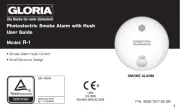
9 Juli 2025
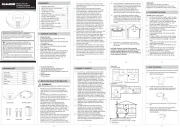
4 Juli 2025
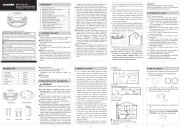
4 Juli 2025

1 Juli 2025
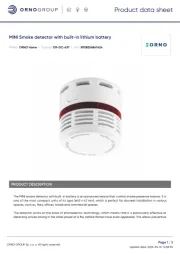
11 Juni 2025
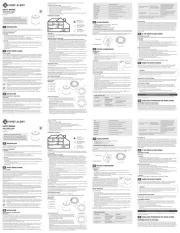
8 Juni 2025
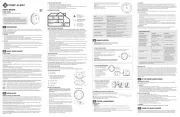
8 Juni 2025
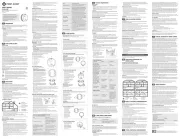
8 Juni 2025

30 Mei 2025